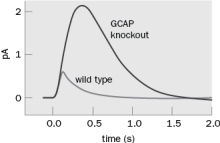Our visual system has a remarkable dynamic range. When you go to a matinee movie (during the daytime) and walk out of the theater it is difficult to see. After a few minutes your eyes adapt to the new light levels. Some of the molecular mechanisms of light adaptation are known and most involve changes in Ca2+ concentration. (A)
(B)
Figure Q4-13
A. Based on the data from the experiments shown in Figure Q4-13, what is one mechanism of adaptation? Figure Q4-13A shows the dark-adapted response to a flash of light in wild type and GCAP knockout mice. Figure Q4-13B shows the rod response to a flash of light relative to the same flash after dark adaptation.
B. What is the probable molecular mechanism of reduced light adaptation involving GCAP?
Correct Answer:
Verified
View Answer
Unlock this answer now
Get Access to more Verified Answers free of charge
Q14: Which cell types in the retina produce
Q15: Why are men more likely to be
Q16: Figure Q4-15 the spectral sensitivity of human
Q17: What is the smallest number of photons
Q18: What is the fovea? Select all that
Q20: The responses of a single rod to
Q21: How does the influence of horizontal cells
Q22: Where does binocular input first occur in
Q23: Besides rods and cones, what is the
Q24: An object of interest is to your
Unlock this Answer For Free Now!
View this answer and more for free by performing one of the following actions

Scan the QR code to install the App and get 2 free unlocks

Unlock quizzes for free by uploading documents